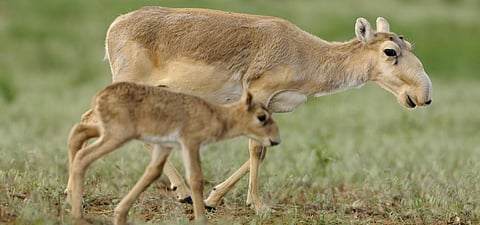

There is some good news for the Saiga, the critically endangered antelope of Asia’s steppes. The smallest and most threatened population of saiga in Kazakhstan, where the species is mostly found, has experienced its largest mass calving in recent years.
530 calves have been born to the Ustyurt Plateau population of saiga. They represent the largest number of calves recorded in recent years.
In 2019, only four calves were found, down from the 57 calves found in 2018.
The Ustyurt population was as large as 265,000 adult individuals in the late 1980s. However, the break-up of the Soviet Union led to large-scale poaching which caused this population along with others dwindle and decline.
Dwarf bamboo threatens alpine plants with extinction in Japan
Alpine plants growing in the mountainous regions of Japan have come under threat due to the sudden growth of dwarf bamboo, that has been aided by global warming.
Due to global warming, snow is melting faster and soil is drying up in these regions. The dwarf bamboo species, Sasa kurilensis blocks the sun’s rays and prevents other plants from performing photosynthesis.
It also absorbs a large amount of water, drying up the soil and preventing alpine plants from growing in wetland areas. Moreover, rising temperatures are causing alpine plants to flower earlier, disturbing their balance with the insects that pollinate them.
Four new fungi species discovered on bat carcasses in China
A subterranean expedition by a group of researchers in China has led to the discovery of four novel fungal species on bat carcasses.
The four new species are Mortierella rhinolophicola; M multispora; M yunnanensis; and Neocosmospora pallidimors.
The expedition, in an underground limestone karst system, was undertaken by researchers from World Agroforestry (ICRAF) East and Central Asia Program-Centre for Mountain Futures and Kunming Institute of Botany (KIB) at the Chinese Academy of Sciences. The results of the study were published in journal Emerging Microbes and Infections on June 30, 2020.
Neocosmospora pallidimors, according to researchers, is particularly important as the Neocosmospora genus is known to contain numerous aggressive pathogens that can infect mammals.
“One of the more alarming findings was that many infections related to Neocosmospora, which have previously been associated with human and animal mycotoxicoses (ingestion of toxins produced by fungi affecting liver and endocrine), are thought to be on the rise,” according to the researchers.
“Another fungi species, T harzanium, is also important as it has suppressing capabilities and may have contributed to protecting bats against other infectious fungi. This may be a totally new ecology,” said Peter Mortimer, the author from KIB.
Villagers in Odisha’s Malkangiri kill, consume meat of mugger crocodile
A group of villagers in Odisha’s Malkangiri district reportedly caught a 10-foot-long mugger crocodile in a fishing net near the Saberi river in Kaldapalli village and consumed its meat July 2, 2020.
The crocodile was thrashed and killed by the villagers, who hung it on a tree in the village for a few hours. A few of them posed next to the crocodile carcass, took photos and videos and shared them on social media.
The state forest department officials, after receiving information of the incident, rushed to the village to investigate the matter.
“We came to know that the villagers brutally thrashed the crocodile and it succumbed to injuries,” said Pradeep Mirase, the Malkangiri divisional forest officer.
It is illegal to kill crocodiles, as they are protected under Schedule I of the Indian Wildlife (Protection) Act, 1972, said Mirase. “We have detained some villagers and are investigating the matter. The culprits will be arrested soon,” he added.
The crocodile was chopped into several pieces and its meat distributed in the village, according to one of the villagers. “When I finally saw it after its capture, I couldn’t believe my eyes. It was big enough to swallow a man all at once,” said an eyewitness.
Mugger or marsh crocodiles have never harmed villagers or domestic animals as this species of crocodiles are less ferocious than others, according to Sudhakar Kar, a herpetologist and former wildlife researcher for Odisha’s forest department.
The crocodiles are satisfied with fish in reservoirs and adjoining ponds, he said. The state’s fishermen are involved in pisciculture in the reservoir and the conservation of crocodiles, he added.
The state’s Ganjam, Koraput, Malkangiri and Mayurbhanj districts are habitats of mugger crocodiles. They are now in danger from the construction of dams, barrages, irrigation canals, siltation, changes in river course, artificial embankments and sand mining.
All these have combined to cause a limitation in the habitats of mugger crocodiles due to excessive, irreversible loss in their riverine habitat, said Kar.